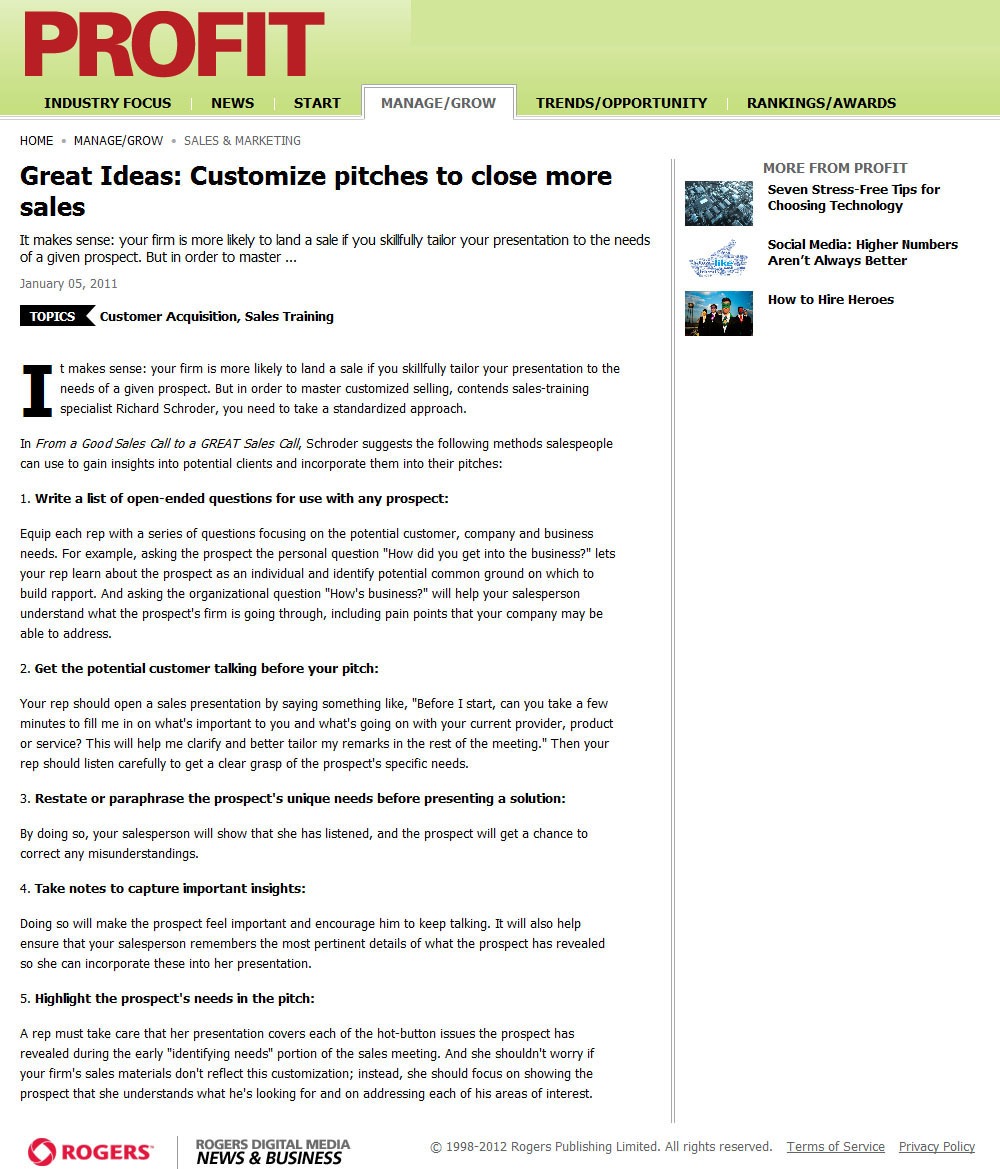
 When delivering a sales presentation to prospects, how frequently is “winging it” the strategy you use? Probably not very often. So, if you strategize and formalize your sales presentation, shouldn’t you do the same when it comes time to understand your prospect’s decision making?
When delivering a sales presentation to prospects, how frequently is “winging it” the strategy you use? Probably not very often. So, if you strategize and formalize your sales presentation, shouldn’t you do the same when it comes time to understand your prospect’s decision making?
Anova’s research has uncovered that only 25% of salespeople use a formal, written-down win / loss interview guide when conducting post-decision debriefs. In other words, 75% of sales debriefs are impromptu and do not adequately allow for obtaining complete and constructive feedback. Just as you would prepare for a presentation, it is important to strategize before the debrief so you can obtain the best feedback possible to learn and benefit from. Here are some of the benefits you will gain from having a formalized win / loss debrief guide:
Now that you know the benefits of formally constructing a win / loss interview guide, you know what key ingredients to add to your survey to truly get the most out of your post-decision discussion!
 Practice? You can probably think of dozens of reasons why not to practice.
Practice? You can probably think of dozens of reasons why not to practice.
It takes too much time.
Practice is boring and is a drain.
You don’t need it. You’ve been selling to prospects and clients forever…
Even as kids growing up, practice seemed like a pain. After all, did any of us want to practice the piano or multiplication tables? As we mature to adults, the reasons to not practice evolve from reasons to excuses, and from excuses to barriers to success.
Practice matters. It makes us better. Just listen to a couple of world renowned athletes like Pele and Michael Jordan.
Pele, widely regarded as the greatest soccer player of all time, said, “Everything is practice.” Michael Jordan, credited with being one of the best basketball players ever and was one of the most effectively marketed athletes of his generation said, “You can practice shooting eight hours a day, but if your technique is wrong, then all you become is very good at shooting the wrong way. Get the fundamentals down and the level of everything you do will rise.”
But what does this have to do with Win / Loss research?
Anova’s team views itself as athletes. We are dedicated to training each of our client’s sales muscles so ultimately their level of competition rises. If you understand why you are winning or losing, you can find out where you need to practice.
Inevitably, feedback from prospects will include commentary about your salesmanship and sales techniques. You may know the product inside and out, but maybe your sales presentation wasn’t customized to the prospect’s unique needs. You may know the pricing structure better than anyone else on your sales team, but perhaps the upfront needs analysis wasn’t good enough and the competition asked more relevant questions, allowing them to come up with the perfect pricing solution. Maybe you came from the service side of your business and are selling because you know how good the implementation and on-going service will be, but you exposed limitations because you were unable to involve the right people during the sales process – and the prospect ended up feeling not as important as they wanted.
Anova’s research identifies the areas needing more practice. If you know where you need to improve your fundamentals, you can practice. If you practice, you will improve. If you improve, you will win more business.
 How much is one sales meeting worth to your business? This past weekend, the NBA’s Golden State Warriors successfully pitched superstar Kevin Durant to join their already-impressive roster led by reigning two-time MVP Steph Curry. Having both players is a huge advantage for Golden State, but the two could have also been part of another team: the list of athletes sponsored by Nike. Instead, Curry’s rise to fame has been all while donning the Under Armour logo on his shoes and clothes, leaving Nike officials to ponder how he got away. Curry’s story parallels much of what Anova finds in our past decade of B2B Win Loss Analysis. The lesson learned: Implementing a Win / Loss analysis program to conduct post-sale debriefs leads companies to be better positioned to improve future sales performance.
How much is one sales meeting worth to your business? This past weekend, the NBA’s Golden State Warriors successfully pitched superstar Kevin Durant to join their already-impressive roster led by reigning two-time MVP Steph Curry. Having both players is a huge advantage for Golden State, but the two could have also been part of another team: the list of athletes sponsored by Nike. Instead, Curry’s rise to fame has been all while donning the Under Armour logo on his shoes and clothes, leaving Nike officials to ponder how he got away. Curry’s story parallels much of what Anova finds in our past decade of B2B Win Loss Analysis. The lesson learned: Implementing a Win / Loss analysis program to conduct post-sale debriefs leads companies to be better positioned to improve future sales performance.
In a recent ESPN article, reporter Ethan Strauss unveiled details of the courtship for the reigning 2-time NBA MVP Curry by top sponsors Nike and Under Armour. Readers learned the cringe-worthy story of how one of the most iconic sports brands in the world lost an athlete worth an estimated $14 billion to one of their top competitors. However, readers may not have fully realized the similarities between Nike’s mistakes and the ones that occur in their own companies’ sales situations. Through the hundreds of Win / Loss interviews Anova conducts each month, trends of similar sales miscues emerge across all industries and deal sizes. Some mistakes are more prevalent than others, but all are avoidable. Let’s take a closer look at how Nike made several common sales mistakes and turned off one of their most promising young stars:
In 2013, Nike met with Curry, a current client at the time, in order to sign him to a contract extension. There was no reason why they shouldn’t have been able to; Curry had been wearing the iconic swoosh on his sneakers his entire life and on top of that, Curry’s godfather was an employee of the Oregon-based company. Still, Nike faltered when it was time to meet with Curry. Instead of bringing their top brass, Nike chose to not include one of their chief athlete advisors who had worked with other basketball stars such as LeBron James. The lack of executive attendees signaled to Curry that Nike did not feel he was important enough to warrant the heightened attention.
Anova has learned by conducting thousands of win / loss interviews that making a prospect feel valued is one of the most important drivers of a winning sales process. In the Curry situation, Nike started off on the wrong foot by not having the right personnel at the sales presentation and compounded the issue by not customizing the pitch properly. Included within Nike’s PowerPoint was a slide with Kevin Durant’s name instead of Curry’s, a sloppy error suggesting the presentation was merely reprocessed material used for another Nike athlete. Adding insult to injury, one Nike official was said to have mispronounced Stephen’s name. Between the recycled PowerPoint and calling Curry by the wrong name, Nike failed to make their client feel valued.
The inability to make a prospect feel important is consistently one of the top sales weaknesses cited by respondents in Win / Loss surveys. In this case, it cost Nike considerably. A failure to understand and address fundamental sales issues can be the difference between winning and losing a key deal, yet it still amazes heads of sales that these mistakes are occurring within their sales teams. In 2015 alone, Anova identified ineffective sales performance as a reason for losing bids in almost 50% of situations!
The real question is: How much is it costing your organization to make the same mistakes as Nike?
Welcome to the Anova Consulting Group Blog! Here at Anova, we pride ourselves in our Win Loss Analysis work helping companies understand why they are winning and losing business and how they can be more competitive in their respective marketplaces. Although our time is mostly spent working closely with our clients and focused on our research, we also have a lot of interesting thoughts that we would love to share with the rest of the world. Hence the birth of this blog.
The idea of this blog is to share industry trends, business perspectives, and even current events, all with a twist relating back to the core principles of our work: gathering feedback, making strategic decisions, becoming more competitive, etc. There may even be the occasional movie or book review, but we promise to keep the topics captivating and insightful. Remember to check back in frequently, and if you are not familiar with us, take some time to poke around the website and meet the Win Loss Research team.
We thank you and encourage any feedback or ideas you are interested in hearing our take on!
For Immediate Release
Contact:
Andrew Cloutier
Anova Consulting Group, LLC
(617) 731-1045
andrew@theanovagroup.com
BROOKLINE, MASS., April 13, 2016 – Anova Consulting Group, a leading provider of Win / Loss analysis and client satisfaction research to financial services, healthcare, and technology companies, announced today the appointment of an operations analyst, Steven Fantes-Emanuelson.
Steven assists the leadership and research teams with Win / Loss client reporting, content editing, and technology advancement. In addition, he works closely with Anova’s research team in helping to identify trends and creating reports across all programs such as Win / Loss analysis, client satisfaction, and intermediary perception programs.
Prior to joining Anova, Steven worked in the non-profit sector for over 15 years. He has a background in Arts Administration, Theatre Performance, and Theatre Education. Steven is a member of VASTA (Voice and Speech Trainer’s Association) and is an Equity Membership Candidate with Actor’s Equity Association.
“In 2015, Anova added 12 new clients across new industries and increased our total interview output by 35%,” said Richard Schroder, president of Anova Consulting Group. “To sustain our growth, we were looking to add an operational and administrative resource to support our leadership and research teams. Steven’s skills will help Anova continue to efficiently deliver high quality, actionable research to our clients. Client service is Anova’s top priority.”
Established in 2005, Anova Consulting Group is a leading market research and consulting firm focused on win / loss and client satisfaction analysis. By helping its clients understand why they win, lose, and retain business, Anova provides strategic perspectives driving better decision making, product development, sales effectiveness, client service, and continuous improvement. Richard Schroder, Founder and President of Anova, is author of a book titled From a Good Sales Call to a Great Sales Call (McGraw-Hill), which details how learning from post-sale debriefing helps close more future sales.

It makes sense: your firm is more likely to land a sale if you skillfully tailor your presentation to the needs of a given prospect. But in order to master …
January 05, 2011
It makes sense: your firm is more likely to land a sale if you skillfully tailor your presentation to the needs of a given prospect. But in order to master customized selling, contends sales-training specialist Richard Schroder, you need to take a standardized approach.
In From a Good Sales Call to a GREAT Sales Call, Schroder suggests the following methods salespeople can use to gain insights into potential clients and incorporate them into their pitches:
1. Write a list of open-ended questions for use with any prospect:
Equip each rep with a series of questions focusing on the potential customer, company and business needs. For example, asking the prospect the personal question “How did you get into the business?” lets your rep learn about the prospect as an individual and identify potential common ground on which to build rapport. And asking the organizational question “How is business?” will help your salesperson understand what the prospects firm is going through, including pain points that your company may be able to address.
2. Get the potential customer talking before your pitch:
Your rep should open a sales presentation by saying something like, “Before I start, can you take a few minutes to fill me in on what is important to you and what is going on with your current provider, product or service? This will help me clarify and better tailor my remarks in the rest of the meeting.” Then your rep should listen carefully to get a clear grasp of the prospect’s specific needs.
3. Restate or paraphrase the prospect’s unique needs before presenting a solution:
By doing so, your salesperson will show that she has listened, and the prospect will get a chance to correct any misunderstandings.
4. Take notes to capture important insights:
Doing so will make the prospect feel important and encourage him to keep talking. It will also help ensure that your salesperson remembers the most pertinent details of what the prospect has revealed so she can incorporate these into her presentation.
5. Highlight the prospects needs in the pitch:
A rep must take care that her presentation covers each of the hot-button issues the prospect has revealed during the early “identifying needs” portion of the sales meeting. And she should not worry if your firms sales materials do not reflect this customization; instead, she should focus on showing the prospect that she understands what he is looking for and on addressing each of his areas of interest.